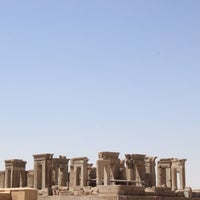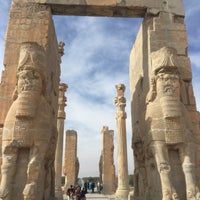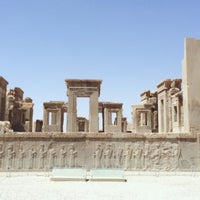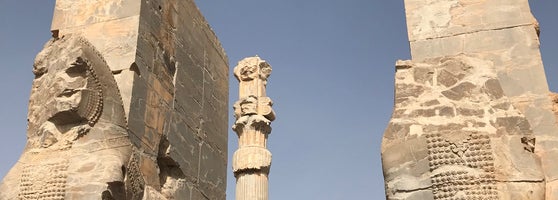

Persepolis
(تخت جمشید)
Historic and Protected Site
مرو دشت
See what your friends are saying about Persepolis.
By creating an account you are able to follow friends and experts you trust and see the places they’ve recommended.
orSign up with emailFilter:
- architecture
- historic sites
- monuments
- spacious
- tours
- (7 more)
Sort:
- Popular
- Recent
- AlirezaOctober 7, 2014Artistically cut stones used to be joined together using lead clips to make them resistant to earthquakes. Metal clips must be replaced or more cracks in the stones would appear over time.
 Upvote26DownvoteUpvoted 1 week ago
Upvote26DownvoteUpvoted 1 week ago - AlirezaOctober 7, 2014It is speculated that in this wonderful carving the lion and the cow are symbols of spring and winter. The lion conquers over the cow as the first day of spring (Nowruz) emerges.
 Upvote20DownvoteUpvoted 1 week ago
Upvote20DownvoteUpvoted 1 week ago - Yasi. PkhFebruary 14, 2019All tourists must see this place to see and understand great iran.i impressed and enjoy hereUpvote6DownvoteUpvoted 2 weeks ago
- Siavash RazaviJuly 23, 2021Persepolis (/pərˈsɛpəlɪs/; Old Persian: 𐎱𐎠𐎼𐎿; New Persian: تخت جمشید, romanized: Takht-e Jamshīd, lit. 'Throne of Jamshid') was the ceremonial capital of the Achaemenid Empire (c. 550–330 BC).
 Upvote1Downvote
Upvote1Downvote - AlirezaOctober 7, 2014Two giant sphinxes depicted with bull's body, eagle's wings, and bearded man's head are standing at the eastern doorway of the Gate of All Nations.
 Upvote6Downvote
Upvote6Downvote - Hooman ShalchiApril 30, 2017Words can not describe it! Fascinating-Amazing-Spectacular. DO NOT miss it if you are around.
 Upvote1Downvote
Upvote1Downvote - Aslan SpringFebruary 16, 2016A nation's history lies here. Amazing architecture with enigmatic masonry technology. Every body have to visit this place once in their lifeUpvote1Downvote
- Matthew BradeyJanuary 3, 2019The preserved stone carvings are great. Also take the time to climb up to both tombs. Use a guide and hire the VR headsets.UpvoteDownvote
- AlirezaOctober 6, 2014Trained guides are available, but they only accompany a group of visitors if they are paid 35 thousand Tomans. The more the number of people in the group, the less every individual's share.Upvote1Downvote
- Romina zamaniApril 15, 2019Remember when you want to go to this place you need time to look carefully!
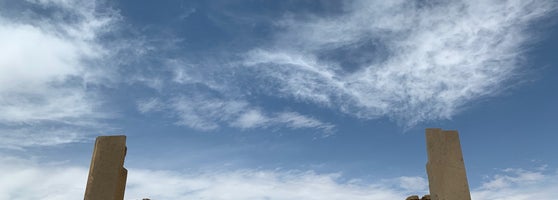 Upvote1Downvote
Upvote1Downvote - Mohammad AmirRahmaniMarch 22, 2017Awesome! Its greatness in all aspects bedazzled me.
 Upvote1Downvote
Upvote1Downvote - Parastoo ShJuly 19, 2016Historical place , i think everyone in the world heard about this place , i can't describe how amazing is this place in wordsUpvoteDownvote
- Yosra HmlApril 28, 2017amazing place for the people who love history,power and originality!
 UpvoteDownvote
UpvoteDownvote - FarzadApril 23, 2013Persepolis was the ceremonial capital of the Achaemenid Empire. In the year 330 BCE Alexander the Great conquered the Persepolis and after looting its treasures, burned it to the ground.
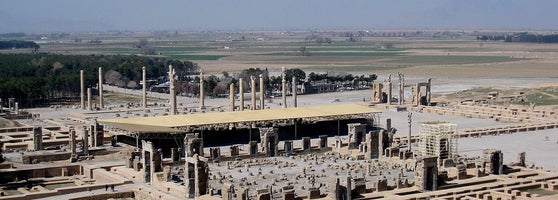 Upvote15Downvote
Upvote15Downvote - Sara EhsaniJune 27, 2021It's awesome, it's great, it shows what we had and what we was. Any one must see Perspolis at least once.UpvoteDownvote
- Kourosh ChahardoriOctober 2, 2024Walking in the heart of the most magnificent empire in history!
 UpvoteDownvote
UpvoteDownvote - A majestic presentation of Persian art and architecture, in one word Pride of the PersiansUpvote4Downvote
- Helia HadaviSeptember 11, 2015The ancient remains of Darius and his descendants palace were very detailed and breathtaking!!😍😍UpvoteDownvote
- Anna ChernovaApril 2, 2013Avoid Nowruz' crowds. Awesome stuff. "Pay your taxes" bas-reliefs.Upvote4Downvote
- JSeptember 29, 2015Post box at the stores near the entrance; bring shades and sunscreenUpvoteDownvote
- Kemal KayaSeptember 11, 2013Persepolis was the capital of the Achaemenid Empire. The magnificent palace complex. Read moreUpvoteDownvote
- Dr. Maşuk Cahit UysalJune 10, 2021Gelirken heredotun tarih kitabını almıştım, içeriğini bilmeden. Çok güzel isabet oldu, pers kültürünü ve Darius’u öğrenmek için okuyun. İranlıların geneli okumuş.Upvote1Downvote
- César CarazoApril 25, 2017Visita indispensable en Irán! Impresionante la escalera y las tumbas de la semana reyes persas.
 Upvote1Downvote
Upvote1Downvote - Tota Q8February 8, 2015حبيت المكان نفس الاهرامات بالضبط وكالعاده مافي اهتمام باللغه الانجليزية للسياح مانفهم شي كله بلغتهم برغم وجود صينيين واجانب وعرب زايرين المكان والمكان روعه لو يهتمون فيه
 UpvoteDownvote
UpvoteDownvote - Nakisa SalehiMay 26, 2016برين ببينين تا قبل از اينكه همين ١٧ تا ستوني كه از كل ٨٠٠ و خورده اي ستون مونده از بين نرفتنUpvoteDownvote
- Tannaz NouriJuly 10, 2016به جرات ميگم كه موزه لوور پاريس كنار گوشمون ولي قدر نميدونيم 😔
 Upvote3Downvote
Upvote3Downvote - Denis VasilevMarch 10, 2015Развалины древней столицы персидской империи, когда все фигурки и статуи были цветные!Upvote1Downvote
- Ghazal MaboudiMay 15, 2015هر جاي ديگه ي دنيا بود از يك بنايي با اين هنر معماري و با اين نبوغ شهر سازي باستاني به طرز فوق العاده اي نگه داري ميشد،حيف كه ما فرهنگ نگه داشتن نبوغ پيشينيان رو نداريم،حيف.....UpvoteDownvote
- ParinazDecember 24, 2015واااااي اصن ميرم اينجا يه حس عجيبي ميگيرم.راهنما بگيرين حتما.توي فصل گرما و سرما نريد خيلي بهتره كه بتونين كامل استفاده كنيد از تخت جمشيد 👌🏼👌🏼UpvoteDownvote
- Mohi MirdamadiOctober 26, 2015دیدن این مکان اعجاب انگیز رو با استفاده از راهنماهایی که اونجا مستقر هستند و با صرف هزینهای حدود ۴۰ هزار تومان کامل کنید. به نظر من کاملا ارزشش رو داره.UpvoteDownvote
